Analyzing Managerial Decision-Making Processes in Business
VerifiedAdded on 2020/06/04
|12
|4913
|62
AI Summary
The assignment centers on evaluating managerial decision-making processes by understanding relevant theories, recognizing biases, and applying this knowledge in practical contexts. It involves a comprehensive analysis of how decisions can be improved through strategic interventions and a demonstration of effective communication and presentation skills.
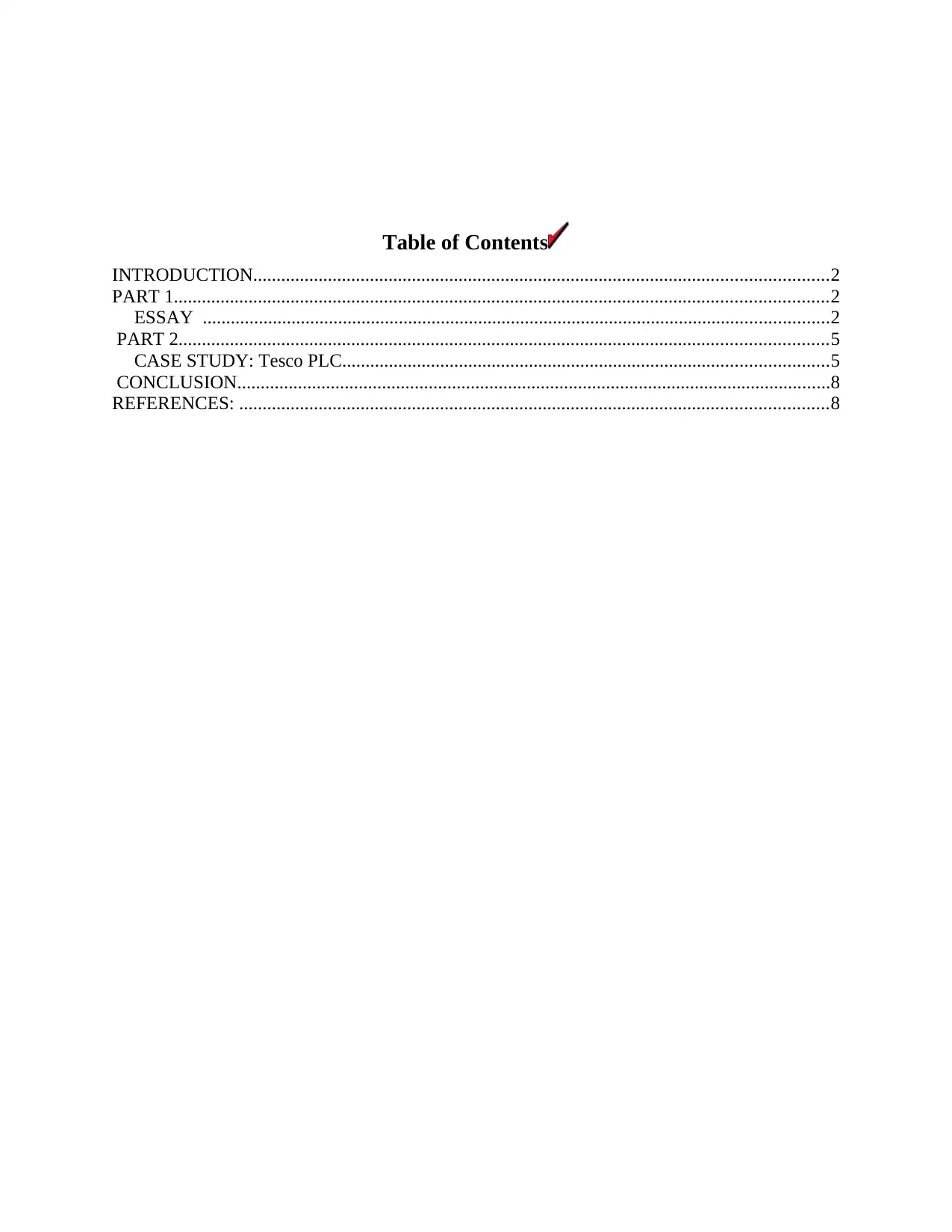
Table of Contents
INTRODUCTION...........................................................................................................................2
PART 1............................................................................................................................................2
ESSAY ......................................................................................................................................2
PART 2...........................................................................................................................................5
CASE STUDY: Tesco PLC........................................................................................................5
CONCLUSION...............................................................................................................................8
REFERENCES: ..............................................................................................................................8
INTRODUCTION...........................................................................................................................2
PART 1............................................................................................................................................2
ESSAY ......................................................................................................................................2
PART 2...........................................................................................................................................5
CASE STUDY: Tesco PLC........................................................................................................5
CONCLUSION...............................................................................................................................8
REFERENCES: ..............................................................................................................................8
Paraphrase This Document
Need a fresh take? Get an instant paraphrase of this document with our AI Paraphraser
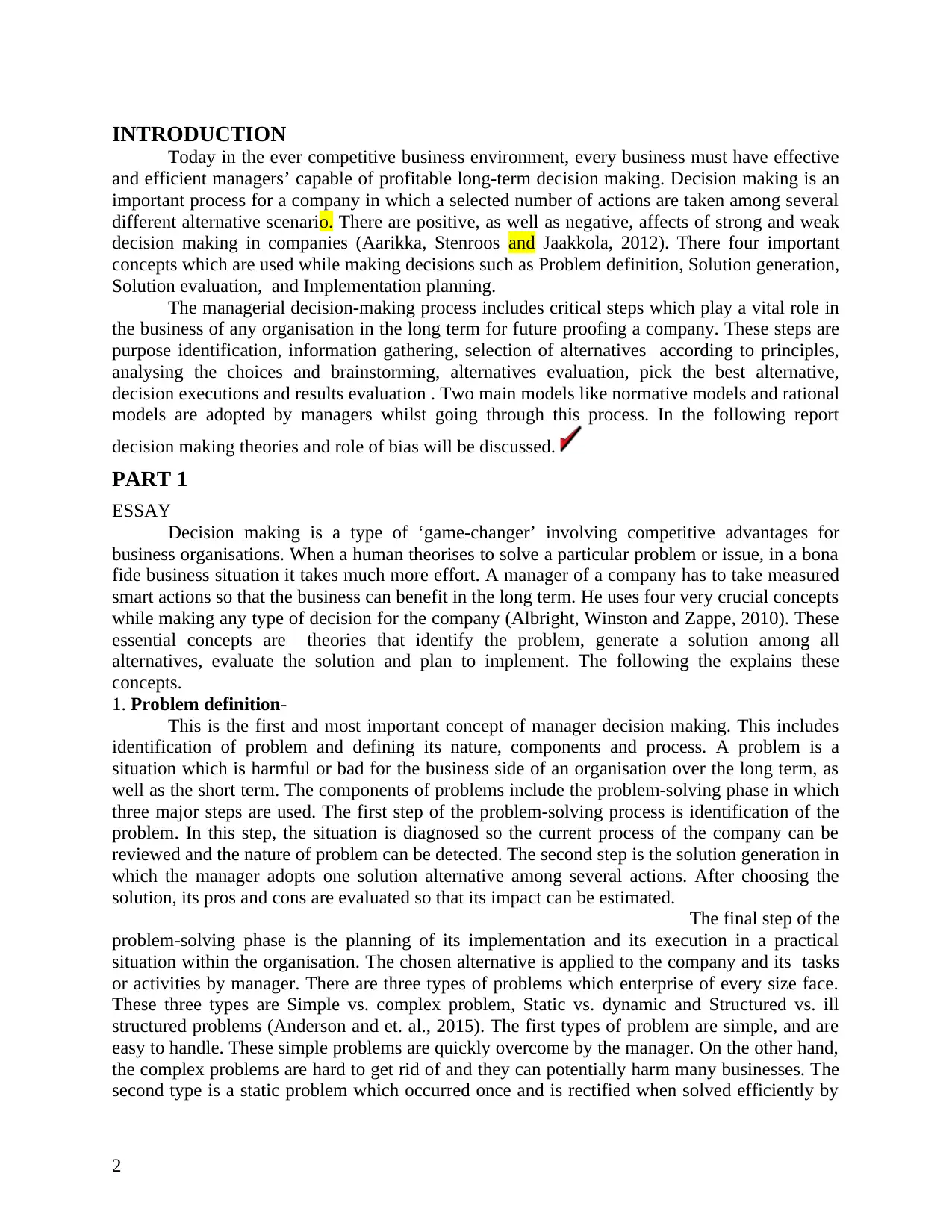
INTRODUCTION
Today in the ever competitive business environment, every business must have effective
and efficient managers’ capable of profitable long-term decision making. Decision making is an
important process for a company in which a selected number of actions are taken among several
different alternative scenario. There are positive, as well as negative, affects of strong and weak
decision making in companies (Aarikka, Stenroos and Jaakkola, 2012). There four important
concepts which are used while making decisions such as Problem definition, Solution generation,
Solution evaluation, and Implementation planning.
The managerial decision-making process includes critical steps which play a vital role in
the business of any organisation in the long term for future proofing a company. These steps are
purpose identification, information gathering, selection of alternatives according to principles,
analysing the choices and brainstorming, alternatives evaluation, pick the best alternative,
decision executions and results evaluation . Two main models like normative models and rational
models are adopted by managers whilst going through this process. In the following report
decision making theories and role of bias will be discussed.
PART 1
ESSAY
Decision making is a type of ‘game-changer’ involving competitive advantages for
business organisations. When a human theorises to solve a particular problem or issue, in a bona
fide business situation it takes much more effort. A manager of a company has to take measured
smart actions so that the business can benefit in the long term. He uses four very crucial concepts
while making any type of decision for the company (Albright, Winston and Zappe, 2010). These
essential concepts are theories that identify the problem, generate a solution among all
alternatives, evaluate the solution and plan to implement. The following the explains these
concepts.
1. Problem definition-
This is the first and most important concept of manager decision making. This includes
identification of problem and defining its nature, components and process. A problem is a
situation which is harmful or bad for the business side of an organisation over the long term, as
well as the short term. The components of problems include the problem-solving phase in which
three major steps are used. The first step of the problem-solving process is identification of the
problem. In this step, the situation is diagnosed so the current process of the company can be
reviewed and the nature of problem can be detected. The second step is the solution generation in
which the manager adopts one solution alternative among several actions. After choosing the
solution, its pros and cons are evaluated so that its impact can be estimated.
The final step of the
problem-solving phase is the planning of its implementation and its execution in a practical
situation within the organisation. The chosen alternative is applied to the company and its tasks
or activities by manager. There are three types of problems which enterprise of every size face.
These three types are Simple vs. complex problem, Static vs. dynamic and Structured vs. ill
structured problems (Anderson and et. al., 2015). The first types of problem are simple, and are
easy to handle. These simple problems are quickly overcome by the manager. On the other hand,
the complex problems are hard to get rid of and they can potentially harm many businesses. The
second type is a static problem which occurred once and is rectified when solved efficiently by
2
Today in the ever competitive business environment, every business must have effective
and efficient managers’ capable of profitable long-term decision making. Decision making is an
important process for a company in which a selected number of actions are taken among several
different alternative scenario. There are positive, as well as negative, affects of strong and weak
decision making in companies (Aarikka, Stenroos and Jaakkola, 2012). There four important
concepts which are used while making decisions such as Problem definition, Solution generation,
Solution evaluation, and Implementation planning.
The managerial decision-making process includes critical steps which play a vital role in
the business of any organisation in the long term for future proofing a company. These steps are
purpose identification, information gathering, selection of alternatives according to principles,
analysing the choices and brainstorming, alternatives evaluation, pick the best alternative,
decision executions and results evaluation . Two main models like normative models and rational
models are adopted by managers whilst going through this process. In the following report
decision making theories and role of bias will be discussed.
PART 1
ESSAY
Decision making is a type of ‘game-changer’ involving competitive advantages for
business organisations. When a human theorises to solve a particular problem or issue, in a bona
fide business situation it takes much more effort. A manager of a company has to take measured
smart actions so that the business can benefit in the long term. He uses four very crucial concepts
while making any type of decision for the company (Albright, Winston and Zappe, 2010). These
essential concepts are theories that identify the problem, generate a solution among all
alternatives, evaluate the solution and plan to implement. The following the explains these
concepts.
1. Problem definition-
This is the first and most important concept of manager decision making. This includes
identification of problem and defining its nature, components and process. A problem is a
situation which is harmful or bad for the business side of an organisation over the long term, as
well as the short term. The components of problems include the problem-solving phase in which
three major steps are used. The first step of the problem-solving process is identification of the
problem. In this step, the situation is diagnosed so the current process of the company can be
reviewed and the nature of problem can be detected. The second step is the solution generation in
which the manager adopts one solution alternative among several actions. After choosing the
solution, its pros and cons are evaluated so that its impact can be estimated.
The final step of the
problem-solving phase is the planning of its implementation and its execution in a practical
situation within the organisation. The chosen alternative is applied to the company and its tasks
or activities by manager. There are three types of problems which enterprise of every size face.
These three types are Simple vs. complex problem, Static vs. dynamic and Structured vs. ill
structured problems (Anderson and et. al., 2015). The first types of problem are simple, and are
easy to handle. These simple problems are quickly overcome by the manager. On the other hand,
the complex problems are hard to get rid of and they can potentially harm many businesses. The
second type is a static problem which occurred once and is rectified when solved efficiently by
2
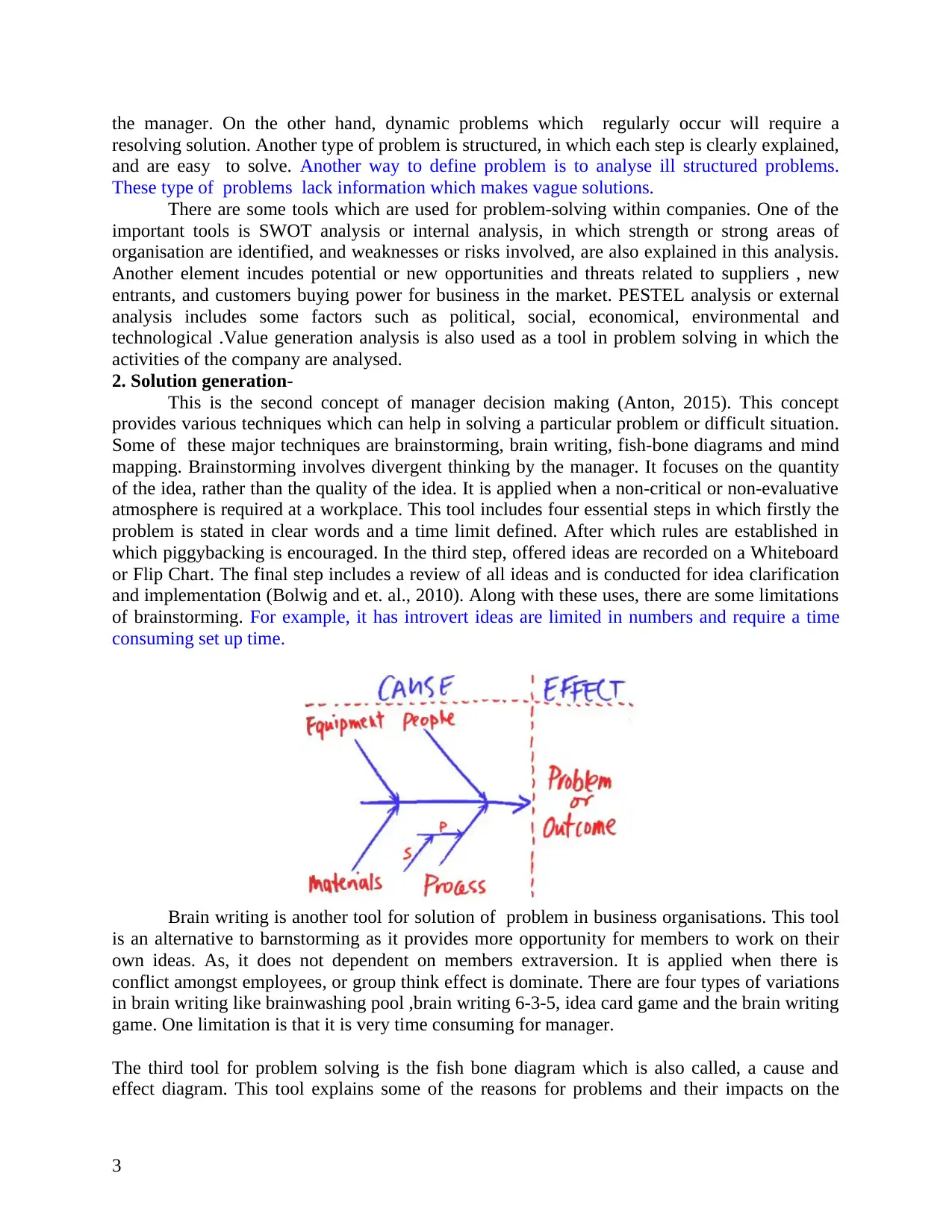
the manager. On the other hand, dynamic problems which regularly occur will require a
resolving solution. Another type of problem is structured, in which each step is clearly explained,
and are easy to solve. Another way to define problem is to analyse ill structured problems.
These type of problems lack information which makes vague solutions.
There are some tools which are used for problem-solving within companies. One of the
important tools is SWOT analysis or internal analysis, in which strength or strong areas of
organisation are identified, and weaknesses or risks involved, are also explained in this analysis.
Another element incudes potential or new opportunities and threats related to suppliers , new
entrants, and customers buying power for business in the market. PESTEL analysis or external
analysis includes some factors such as political, social, economical, environmental and
technological .Value generation analysis is also used as a tool in problem solving in which the
activities of the company are analysed.
2. Solution generation-
This is the second concept of manager decision making (Anton, 2015). This concept
provides various techniques which can help in solving a particular problem or difficult situation.
Some of these major techniques are brainstorming, brain writing, fish-bone diagrams and mind
mapping. Brainstorming involves divergent thinking by the manager. It focuses on the quantity
of the idea, rather than the quality of the idea. It is applied when a non-critical or non-evaluative
atmosphere is required at a workplace. This tool includes four essential steps in which firstly the
problem is stated in clear words and a time limit defined. After which rules are established in
which piggybacking is encouraged. In the third step, offered ideas are recorded on a Whiteboard
or Flip Chart. The final step includes a review of all ideas and is conducted for idea clarification
and implementation (Bolwig and et. al., 2010). Along with these uses, there are some limitations
of brainstorming. For example, it has introvert ideas are limited in numbers and require a time
consuming set up time.
Brain writing is another tool for solution of problem in business organisations. This tool
is an alternative to barnstorming as it provides more opportunity for members to work on their
own ideas. As, it does not dependent on members extraversion. It is applied when there is
conflict amongst employees, or group think effect is dominate. There are four types of variations
in brain writing like brainwashing pool ,brain writing 6-3-5, idea card game and the brain writing
game. One limitation is that it is very time consuming for manager.
The third tool for problem solving is the fish bone diagram which is also called, a cause and
effect diagram. This tool explains some of the reasons for problems and their impacts on the
3
resolving solution. Another type of problem is structured, in which each step is clearly explained,
and are easy to solve. Another way to define problem is to analyse ill structured problems.
These type of problems lack information which makes vague solutions.
There are some tools which are used for problem-solving within companies. One of the
important tools is SWOT analysis or internal analysis, in which strength or strong areas of
organisation are identified, and weaknesses or risks involved, are also explained in this analysis.
Another element incudes potential or new opportunities and threats related to suppliers , new
entrants, and customers buying power for business in the market. PESTEL analysis or external
analysis includes some factors such as political, social, economical, environmental and
technological .Value generation analysis is also used as a tool in problem solving in which the
activities of the company are analysed.
2. Solution generation-
This is the second concept of manager decision making (Anton, 2015). This concept
provides various techniques which can help in solving a particular problem or difficult situation.
Some of these major techniques are brainstorming, brain writing, fish-bone diagrams and mind
mapping. Brainstorming involves divergent thinking by the manager. It focuses on the quantity
of the idea, rather than the quality of the idea. It is applied when a non-critical or non-evaluative
atmosphere is required at a workplace. This tool includes four essential steps in which firstly the
problem is stated in clear words and a time limit defined. After which rules are established in
which piggybacking is encouraged. In the third step, offered ideas are recorded on a Whiteboard
or Flip Chart. The final step includes a review of all ideas and is conducted for idea clarification
and implementation (Bolwig and et. al., 2010). Along with these uses, there are some limitations
of brainstorming. For example, it has introvert ideas are limited in numbers and require a time
consuming set up time.
Brain writing is another tool for solution of problem in business organisations. This tool
is an alternative to barnstorming as it provides more opportunity for members to work on their
own ideas. As, it does not dependent on members extraversion. It is applied when there is
conflict amongst employees, or group think effect is dominate. There are four types of variations
in brain writing like brainwashing pool ,brain writing 6-3-5, idea card game and the brain writing
game. One limitation is that it is very time consuming for manager.
The third tool for problem solving is the fish bone diagram which is also called, a cause and
effect diagram. This tool explains some of the reasons for problems and their impacts on the
3
⊘ This is a preview!⊘
Do you want full access?
Subscribe today to unlock all pages.

Trusted by 1+ million students worldwide
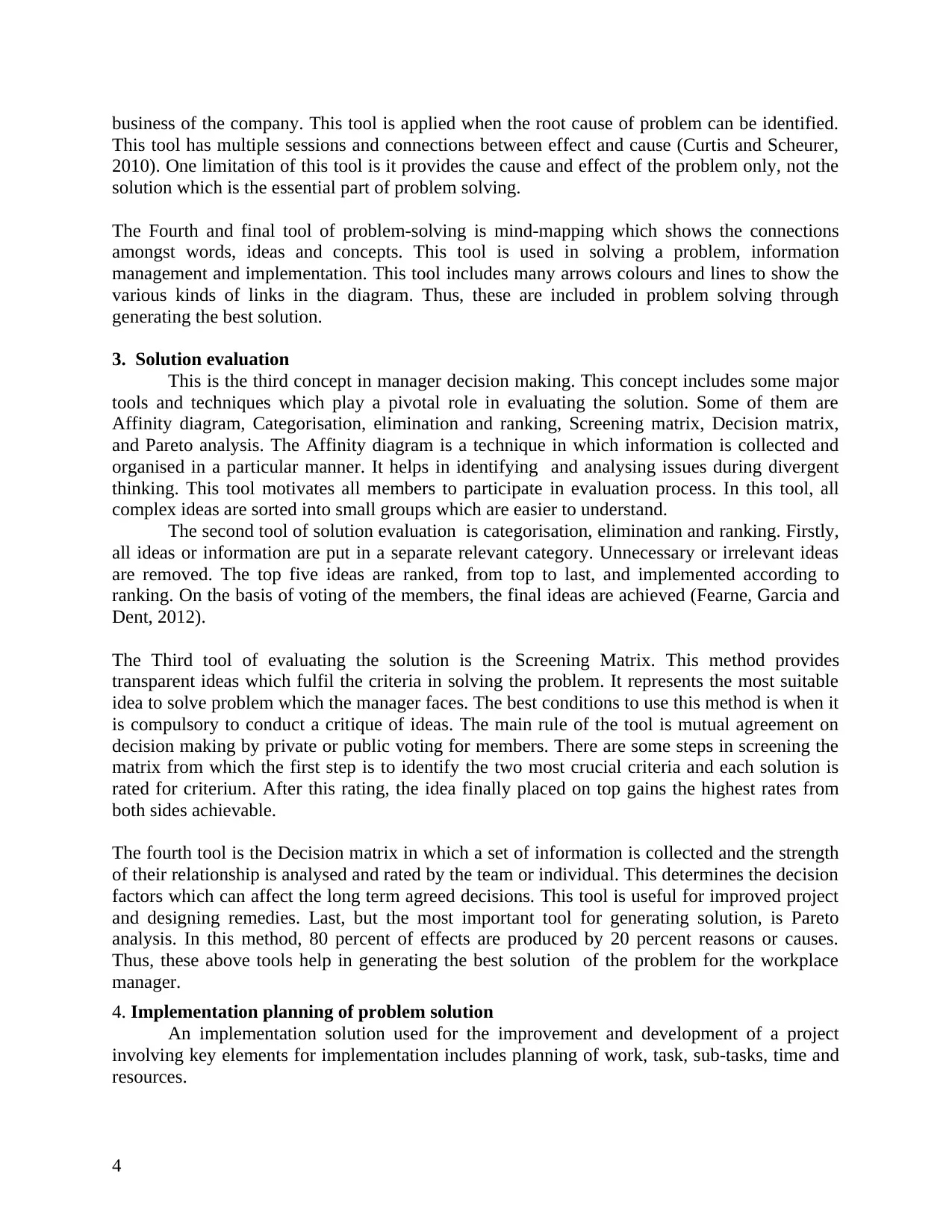
business of the company. This tool is applied when the root cause of problem can be identified.
This tool has multiple sessions and connections between effect and cause (Curtis and Scheurer,
2010). One limitation of this tool is it provides the cause and effect of the problem only, not the
solution which is the essential part of problem solving.
The Fourth and final tool of problem-solving is mind-mapping which shows the connections
amongst words, ideas and concepts. This tool is used in solving a problem, information
management and implementation. This tool includes many arrows colours and lines to show the
various kinds of links in the diagram. Thus, these are included in problem solving through
generating the best solution.
3. Solution evaluation
This is the third concept in manager decision making. This concept includes some major
tools and techniques which play a pivotal role in evaluating the solution. Some of them are
Affinity diagram, Categorisation, elimination and ranking, Screening matrix, Decision matrix,
and Pareto analysis. The Affinity diagram is a technique in which information is collected and
organised in a particular manner. It helps in identifying and analysing issues during divergent
thinking. This tool motivates all members to participate in evaluation process. In this tool, all
complex ideas are sorted into small groups which are easier to understand.
The second tool of solution evaluation is categorisation, elimination and ranking. Firstly,
all ideas or information are put in a separate relevant category. Unnecessary or irrelevant ideas
are removed. The top five ideas are ranked, from top to last, and implemented according to
ranking. On the basis of voting of the members, the final ideas are achieved (Fearne, Garcia and
Dent, 2012).
The Third tool of evaluating the solution is the Screening Matrix. This method provides
transparent ideas which fulfil the criteria in solving the problem. It represents the most suitable
idea to solve problem which the manager faces. The best conditions to use this method is when it
is compulsory to conduct a critique of ideas. The main rule of the tool is mutual agreement on
decision making by private or public voting for members. There are some steps in screening the
matrix from which the first step is to identify the two most crucial criteria and each solution is
rated for criterium. After this rating, the idea finally placed on top gains the highest rates from
both sides achievable.
The fourth tool is the Decision matrix in which a set of information is collected and the strength
of their relationship is analysed and rated by the team or individual. This determines the decision
factors which can affect the long term agreed decisions. This tool is useful for improved project
and designing remedies. Last, but the most important tool for generating solution, is Pareto
analysis. In this method, 80 percent of effects are produced by 20 percent reasons or causes.
Thus, these above tools help in generating the best solution of the problem for the workplace
manager.
4. Implementation planning of problem solution
An implementation solution used for the improvement and development of a project
involving key elements for implementation includes planning of work, task, sub-tasks, time and
resources.
4
This tool has multiple sessions and connections between effect and cause (Curtis and Scheurer,
2010). One limitation of this tool is it provides the cause and effect of the problem only, not the
solution which is the essential part of problem solving.
The Fourth and final tool of problem-solving is mind-mapping which shows the connections
amongst words, ideas and concepts. This tool is used in solving a problem, information
management and implementation. This tool includes many arrows colours and lines to show the
various kinds of links in the diagram. Thus, these are included in problem solving through
generating the best solution.
3. Solution evaluation
This is the third concept in manager decision making. This concept includes some major
tools and techniques which play a pivotal role in evaluating the solution. Some of them are
Affinity diagram, Categorisation, elimination and ranking, Screening matrix, Decision matrix,
and Pareto analysis. The Affinity diagram is a technique in which information is collected and
organised in a particular manner. It helps in identifying and analysing issues during divergent
thinking. This tool motivates all members to participate in evaluation process. In this tool, all
complex ideas are sorted into small groups which are easier to understand.
The second tool of solution evaluation is categorisation, elimination and ranking. Firstly,
all ideas or information are put in a separate relevant category. Unnecessary or irrelevant ideas
are removed. The top five ideas are ranked, from top to last, and implemented according to
ranking. On the basis of voting of the members, the final ideas are achieved (Fearne, Garcia and
Dent, 2012).
The Third tool of evaluating the solution is the Screening Matrix. This method provides
transparent ideas which fulfil the criteria in solving the problem. It represents the most suitable
idea to solve problem which the manager faces. The best conditions to use this method is when it
is compulsory to conduct a critique of ideas. The main rule of the tool is mutual agreement on
decision making by private or public voting for members. There are some steps in screening the
matrix from which the first step is to identify the two most crucial criteria and each solution is
rated for criterium. After this rating, the idea finally placed on top gains the highest rates from
both sides achievable.
The fourth tool is the Decision matrix in which a set of information is collected and the strength
of their relationship is analysed and rated by the team or individual. This determines the decision
factors which can affect the long term agreed decisions. This tool is useful for improved project
and designing remedies. Last, but the most important tool for generating solution, is Pareto
analysis. In this method, 80 percent of effects are produced by 20 percent reasons or causes.
Thus, these above tools help in generating the best solution of the problem for the workplace
manager.
4. Implementation planning of problem solution
An implementation solution used for the improvement and development of a project
involving key elements for implementation includes planning of work, task, sub-tasks, time and
resources.
4
Paraphrase This Document
Need a fresh take? Get an instant paraphrase of this document with our AI Paraphraser
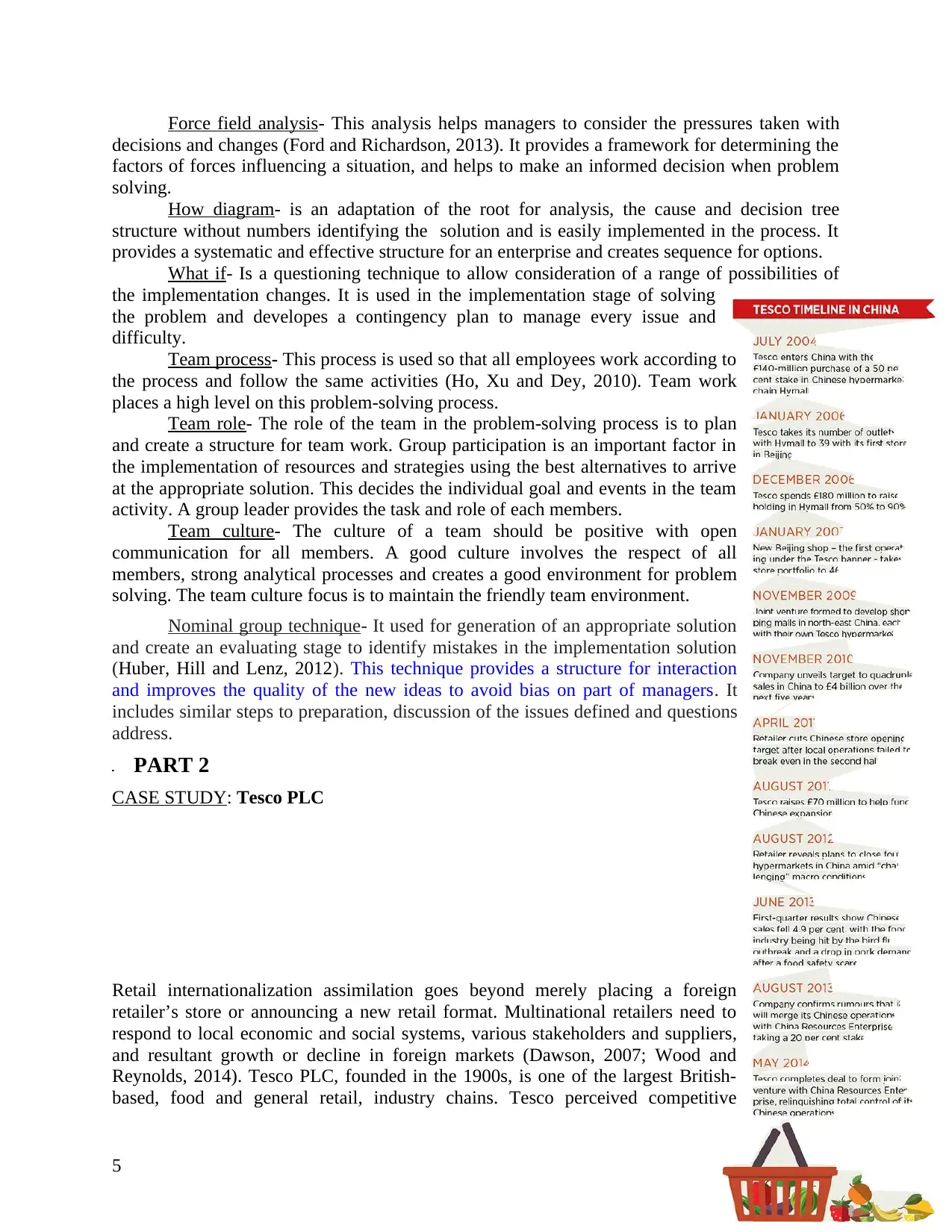
Force field analysis- This analysis helps managers to consider the pressures taken with
decisions and changes (Ford and Richardson, 2013). It provides a framework for determining the
factors of forces influencing a situation, and helps to make an informed decision when problem
solving.
How diagram- is an adaptation of the root for analysis, the cause and decision tree
structure without numbers identifying the solution and is easily implemented in the process. It
provides a systematic and effective structure for an enterprise and creates sequence for options.
What if- Is a questioning technique to allow consideration of a range of possibilities of
the implementation changes. It is used in the implementation stage of solving
the problem and developes a contingency plan to manage every issue and
difficulty.
Team process- This process is used so that all employees work according to
the process and follow the same activities (Ho, Xu and Dey, 2010). Team work
places a high level on this problem-solving process.
Team role- The role of the team in the problem-solving process is to plan
and create a structure for team work. Group participation is an important factor in
the implementation of resources and strategies using the best alternatives to arrive
at the appropriate solution. This decides the individual goal and events in the team
activity. A group leader provides the task and role of each members.
Team culture- The culture of a team should be positive with open
communication for all members. A good culture involves the respect of all
members, strong analytical processes and creates a good environment for problem
solving. The team culture focus is to maintain the friendly team environment.
Nominal group technique- It used for generation of an appropriate solution
and create an evaluating stage to identify mistakes in the implementation solution
(Huber, Hill and Lenz, 2012). This technique provides a structure for interaction
and improves the quality of the new ideas to avoid bias on part of managers. It
includes similar steps to preparation, discussion of the issues defined and questions
address.
PART 2
CASE STUDY: Tesco PLC
Retail internationalization assimilation goes beyond merely placing a foreign
retailer’s store or announcing a new retail format. Multinational retailers need to
respond to local economic and social systems, various stakeholders and suppliers,
and resultant growth or decline in foreign markets (Dawson, 2007; Wood and
Reynolds, 2014). Tesco PLC, founded in the 1900s, is one of the largest British-
based, food and general retail, industry chains. Tesco perceived competitive
5
decisions and changes (Ford and Richardson, 2013). It provides a framework for determining the
factors of forces influencing a situation, and helps to make an informed decision when problem
solving.
How diagram- is an adaptation of the root for analysis, the cause and decision tree
structure without numbers identifying the solution and is easily implemented in the process. It
provides a systematic and effective structure for an enterprise and creates sequence for options.
What if- Is a questioning technique to allow consideration of a range of possibilities of
the implementation changes. It is used in the implementation stage of solving
the problem and developes a contingency plan to manage every issue and
difficulty.
Team process- This process is used so that all employees work according to
the process and follow the same activities (Ho, Xu and Dey, 2010). Team work
places a high level on this problem-solving process.
Team role- The role of the team in the problem-solving process is to plan
and create a structure for team work. Group participation is an important factor in
the implementation of resources and strategies using the best alternatives to arrive
at the appropriate solution. This decides the individual goal and events in the team
activity. A group leader provides the task and role of each members.
Team culture- The culture of a team should be positive with open
communication for all members. A good culture involves the respect of all
members, strong analytical processes and creates a good environment for problem
solving. The team culture focus is to maintain the friendly team environment.
Nominal group technique- It used for generation of an appropriate solution
and create an evaluating stage to identify mistakes in the implementation solution
(Huber, Hill and Lenz, 2012). This technique provides a structure for interaction
and improves the quality of the new ideas to avoid bias on part of managers. It
includes similar steps to preparation, discussion of the issues defined and questions
address.
PART 2
CASE STUDY: Tesco PLC
Retail internationalization assimilation goes beyond merely placing a foreign
retailer’s store or announcing a new retail format. Multinational retailers need to
respond to local economic and social systems, various stakeholders and suppliers,
and resultant growth or decline in foreign markets (Dawson, 2007; Wood and
Reynolds, 2014). Tesco PLC, founded in the 1900s, is one of the largest British-
based, food and general retail, industry chains. Tesco perceived competitive
5
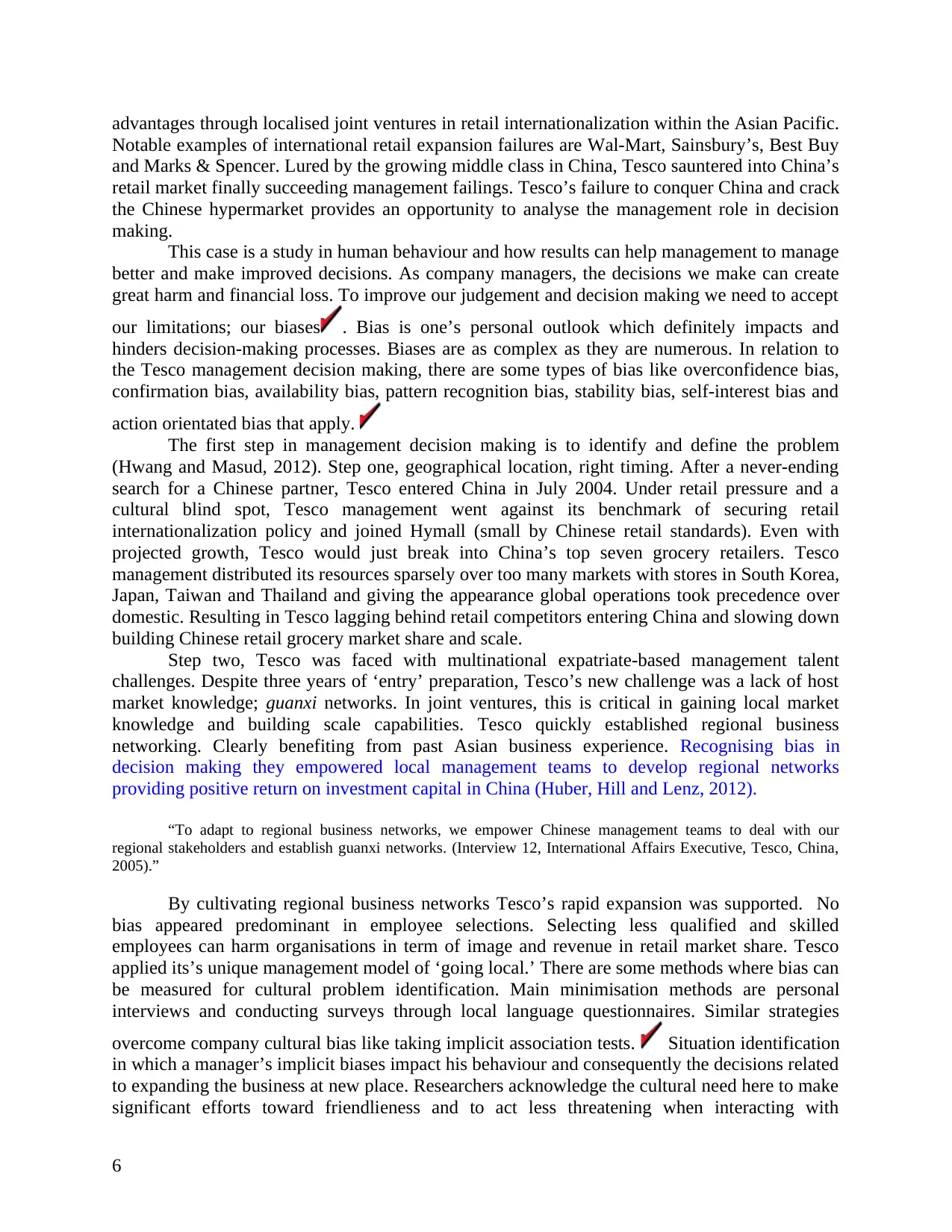
advantages through localised joint ventures in retail internationalization within the Asian Pacific.
Notable examples of international retail expansion failures are Wal-Mart, Sainsbury’s, Best Buy
and Marks & Spencer. Lured by the growing middle class in China, Tesco sauntered into China’s
retail market finally succeeding management failings. Tesco’s failure to conquer China and crack
the Chinese hypermarket provides an opportunity to analyse the management role in decision
making.
This case is a study in human behaviour and how results can help management to manage
better and make improved decisions. As company managers, the decisions we make can create
great harm and financial loss. To improve our judgement and decision making we need to accept
our limitations; our biases . Bias is one’s personal outlook which definitely impacts and
hinders decision-making processes. Biases are as complex as they are numerous. In relation to
the Tesco management decision making, there are some types of bias like overconfidence bias,
confirmation bias, availability bias, pattern recognition bias, stability bias, self-interest bias and
action orientated bias that apply.
The first step in management decision making is to identify and define the problem
(Hwang and Masud, 2012). Step one, geographical location, right timing. After a never-ending
search for a Chinese partner, Tesco entered China in July 2004. Under retail pressure and a
cultural blind spot, Tesco management went against its benchmark of securing retail
internationalization policy and joined Hymall (small by Chinese retail standards). Even with
projected growth, Tesco would just break into China’s top seven grocery retailers. Tesco
management distributed its resources sparsely over too many markets with stores in South Korea,
Japan, Taiwan and Thailand and giving the appearance global operations took precedence over
domestic. Resulting in Tesco lagging behind retail competitors entering China and slowing down
building Chinese retail grocery market share and scale.
Step two, Tesco was faced with multinational expatriate-based management talent
challenges. Despite three years of ‘entry’ preparation, Tesco’s new challenge was a lack of host
market knowledge; guanxi networks. In joint ventures, this is critical in gaining local market
knowledge and building scale capabilities. Tesco quickly established regional business
networking. Clearly benefiting from past Asian business experience. Recognising bias in
decision making they empowered local management teams to develop regional networks
providing positive return on investment capital in China (Huber, Hill and Lenz, 2012).
“To adapt to regional business networks, we empower Chinese management teams to deal with our
regional stakeholders and establish guanxi networks. (Interview 12, International Affairs Executive, Tesco, China,
2005).”
By cultivating regional business networks Tesco’s rapid expansion was supported. No
bias appeared predominant in employee selections. Selecting less qualified and skilled
employees can harm organisations in term of image and revenue in retail market share. Tesco
applied its’s unique management model of ‘going local.’ There are some methods where bias can
be measured for cultural problem identification. Main minimisation methods are personal
interviews and conducting surveys through local language questionnaires. Similar strategies
overcome company cultural bias like taking implicit association tests. Situation identification
in which a manager’s implicit biases impact his behaviour and consequently the decisions related
to expanding the business at new place. Researchers acknowledge the cultural need here to make
significant efforts toward friendlieness and to act less threatening when interacting with
6
Notable examples of international retail expansion failures are Wal-Mart, Sainsbury’s, Best Buy
and Marks & Spencer. Lured by the growing middle class in China, Tesco sauntered into China’s
retail market finally succeeding management failings. Tesco’s failure to conquer China and crack
the Chinese hypermarket provides an opportunity to analyse the management role in decision
making.
This case is a study in human behaviour and how results can help management to manage
better and make improved decisions. As company managers, the decisions we make can create
great harm and financial loss. To improve our judgement and decision making we need to accept
our limitations; our biases . Bias is one’s personal outlook which definitely impacts and
hinders decision-making processes. Biases are as complex as they are numerous. In relation to
the Tesco management decision making, there are some types of bias like overconfidence bias,
confirmation bias, availability bias, pattern recognition bias, stability bias, self-interest bias and
action orientated bias that apply.
The first step in management decision making is to identify and define the problem
(Hwang and Masud, 2012). Step one, geographical location, right timing. After a never-ending
search for a Chinese partner, Tesco entered China in July 2004. Under retail pressure and a
cultural blind spot, Tesco management went against its benchmark of securing retail
internationalization policy and joined Hymall (small by Chinese retail standards). Even with
projected growth, Tesco would just break into China’s top seven grocery retailers. Tesco
management distributed its resources sparsely over too many markets with stores in South Korea,
Japan, Taiwan and Thailand and giving the appearance global operations took precedence over
domestic. Resulting in Tesco lagging behind retail competitors entering China and slowing down
building Chinese retail grocery market share and scale.
Step two, Tesco was faced with multinational expatriate-based management talent
challenges. Despite three years of ‘entry’ preparation, Tesco’s new challenge was a lack of host
market knowledge; guanxi networks. In joint ventures, this is critical in gaining local market
knowledge and building scale capabilities. Tesco quickly established regional business
networking. Clearly benefiting from past Asian business experience. Recognising bias in
decision making they empowered local management teams to develop regional networks
providing positive return on investment capital in China (Huber, Hill and Lenz, 2012).
“To adapt to regional business networks, we empower Chinese management teams to deal with our
regional stakeholders and establish guanxi networks. (Interview 12, International Affairs Executive, Tesco, China,
2005).”
By cultivating regional business networks Tesco’s rapid expansion was supported. No
bias appeared predominant in employee selections. Selecting less qualified and skilled
employees can harm organisations in term of image and revenue in retail market share. Tesco
applied its’s unique management model of ‘going local.’ There are some methods where bias can
be measured for cultural problem identification. Main minimisation methods are personal
interviews and conducting surveys through local language questionnaires. Similar strategies
overcome company cultural bias like taking implicit association tests. Situation identification
in which a manager’s implicit biases impact his behaviour and consequently the decisions related
to expanding the business at new place. Researchers acknowledge the cultural need here to make
significant efforts toward friendlieness and to act less threatening when interacting with
6
⊘ This is a preview!⊘
Do you want full access?
Subscribe today to unlock all pages.

Trusted by 1+ million students worldwide
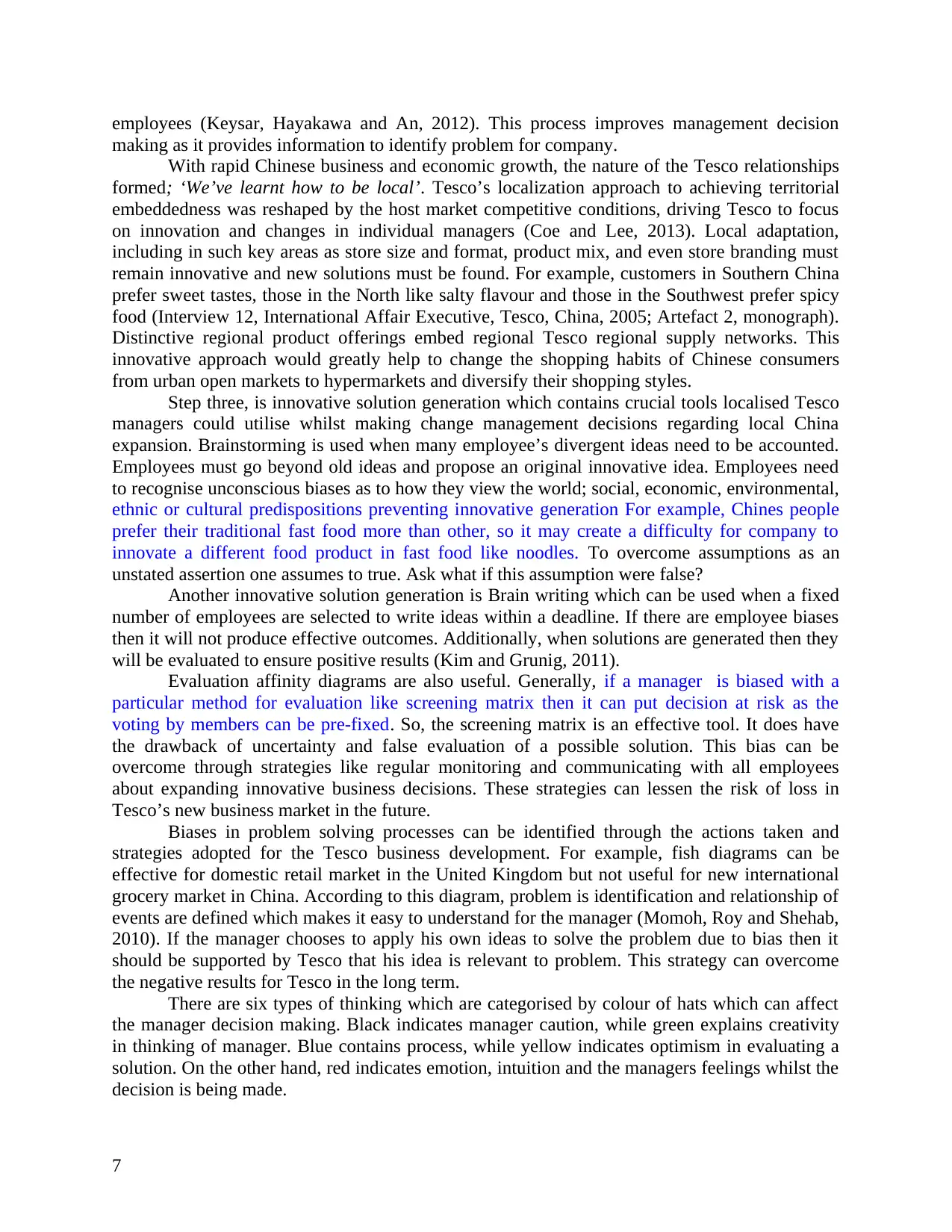
employees (Keysar, Hayakawa and An, 2012). This process improves management decision
making as it provides information to identify problem for company.
With rapid Chinese business and economic growth, the nature of the Tesco relationships
formed; ‘We’ve learnt how to be local’. Tesco’s localization approach to achieving territorial
embeddedness was reshaped by the host market competitive conditions, driving Tesco to focus
on innovation and changes in individual managers (Coe and Lee, 2013). Local adaptation,
including in such key areas as store size and format, product mix, and even store branding must
remain innovative and new solutions must be found. For example, customers in Southern China
prefer sweet tastes, those in the North like salty flavour and those in the Southwest prefer spicy
food (Interview 12, International Affair Executive, Tesco, China, 2005; Artefact 2, monograph).
Distinctive regional product offerings embed regional Tesco regional supply networks. This
innovative approach would greatly help to change the shopping habits of Chinese consumers
from urban open markets to hypermarkets and diversify their shopping styles.
Step three, is innovative solution generation which contains crucial tools localised Tesco
managers could utilise whilst making change management decisions regarding local China
expansion. Brainstorming is used when many employee’s divergent ideas need to be accounted.
Employees must go beyond old ideas and propose an original innovative idea. Employees need
to recognise unconscious biases as to how they view the world; social, economic, environmental,
ethnic or cultural predispositions preventing innovative generation For example, Chines people
prefer their traditional fast food more than other, so it may create a difficulty for company to
innovate a different food product in fast food like noodles. To overcome assumptions as an
unstated assertion one assumes to true. Ask what if this assumption were false?
Another innovative solution generation is Brain writing which can be used when a fixed
number of employees are selected to write ideas within a deadline. If there are employee biases
then it will not produce effective outcomes. Additionally, when solutions are generated then they
will be evaluated to ensure positive results (Kim and Grunig, 2011).
Evaluation affinity diagrams are also useful. Generally, if a manager is biased with a
particular method for evaluation like screening matrix then it can put decision at risk as the
voting by members can be pre-fixed. So, the screening matrix is an effective tool. It does have
the drawback of uncertainty and false evaluation of a possible solution. This bias can be
overcome through strategies like regular monitoring and communicating with all employees
about expanding innovative business decisions. These strategies can lessen the risk of loss in
Tesco’s new business market in the future.
Biases in problem solving processes can be identified through the actions taken and
strategies adopted for the Tesco business development. For example, fish diagrams can be
effective for domestic retail market in the United Kingdom but not useful for new international
grocery market in China. According to this diagram, problem is identification and relationship of
events are defined which makes it easy to understand for the manager (Momoh, Roy and Shehab,
2010). If the manager chooses to apply his own ideas to solve the problem due to bias then it
should be supported by Tesco that his idea is relevant to problem. This strategy can overcome
the negative results for Tesco in the long term.
There are six types of thinking which are categorised by colour of hats which can affect
the manager decision making. Black indicates manager caution, while green explains creativity
in thinking of manager. Blue contains process, while yellow indicates optimism in evaluating a
solution. On the other hand, red indicates emotion, intuition and the managers feelings whilst the
decision is being made.
7
making as it provides information to identify problem for company.
With rapid Chinese business and economic growth, the nature of the Tesco relationships
formed; ‘We’ve learnt how to be local’. Tesco’s localization approach to achieving territorial
embeddedness was reshaped by the host market competitive conditions, driving Tesco to focus
on innovation and changes in individual managers (Coe and Lee, 2013). Local adaptation,
including in such key areas as store size and format, product mix, and even store branding must
remain innovative and new solutions must be found. For example, customers in Southern China
prefer sweet tastes, those in the North like salty flavour and those in the Southwest prefer spicy
food (Interview 12, International Affair Executive, Tesco, China, 2005; Artefact 2, monograph).
Distinctive regional product offerings embed regional Tesco regional supply networks. This
innovative approach would greatly help to change the shopping habits of Chinese consumers
from urban open markets to hypermarkets and diversify their shopping styles.
Step three, is innovative solution generation which contains crucial tools localised Tesco
managers could utilise whilst making change management decisions regarding local China
expansion. Brainstorming is used when many employee’s divergent ideas need to be accounted.
Employees must go beyond old ideas and propose an original innovative idea. Employees need
to recognise unconscious biases as to how they view the world; social, economic, environmental,
ethnic or cultural predispositions preventing innovative generation For example, Chines people
prefer their traditional fast food more than other, so it may create a difficulty for company to
innovate a different food product in fast food like noodles. To overcome assumptions as an
unstated assertion one assumes to true. Ask what if this assumption were false?
Another innovative solution generation is Brain writing which can be used when a fixed
number of employees are selected to write ideas within a deadline. If there are employee biases
then it will not produce effective outcomes. Additionally, when solutions are generated then they
will be evaluated to ensure positive results (Kim and Grunig, 2011).
Evaluation affinity diagrams are also useful. Generally, if a manager is biased with a
particular method for evaluation like screening matrix then it can put decision at risk as the
voting by members can be pre-fixed. So, the screening matrix is an effective tool. It does have
the drawback of uncertainty and false evaluation of a possible solution. This bias can be
overcome through strategies like regular monitoring and communicating with all employees
about expanding innovative business decisions. These strategies can lessen the risk of loss in
Tesco’s new business market in the future.
Biases in problem solving processes can be identified through the actions taken and
strategies adopted for the Tesco business development. For example, fish diagrams can be
effective for domestic retail market in the United Kingdom but not useful for new international
grocery market in China. According to this diagram, problem is identification and relationship of
events are defined which makes it easy to understand for the manager (Momoh, Roy and Shehab,
2010). If the manager chooses to apply his own ideas to solve the problem due to bias then it
should be supported by Tesco that his idea is relevant to problem. This strategy can overcome
the negative results for Tesco in the long term.
There are six types of thinking which are categorised by colour of hats which can affect
the manager decision making. Black indicates manager caution, while green explains creativity
in thinking of manager. Blue contains process, while yellow indicates optimism in evaluating a
solution. On the other hand, red indicates emotion, intuition and the managers feelings whilst the
decision is being made.
7
Paraphrase This Document
Need a fresh take? Get an instant paraphrase of this document with our AI Paraphraser
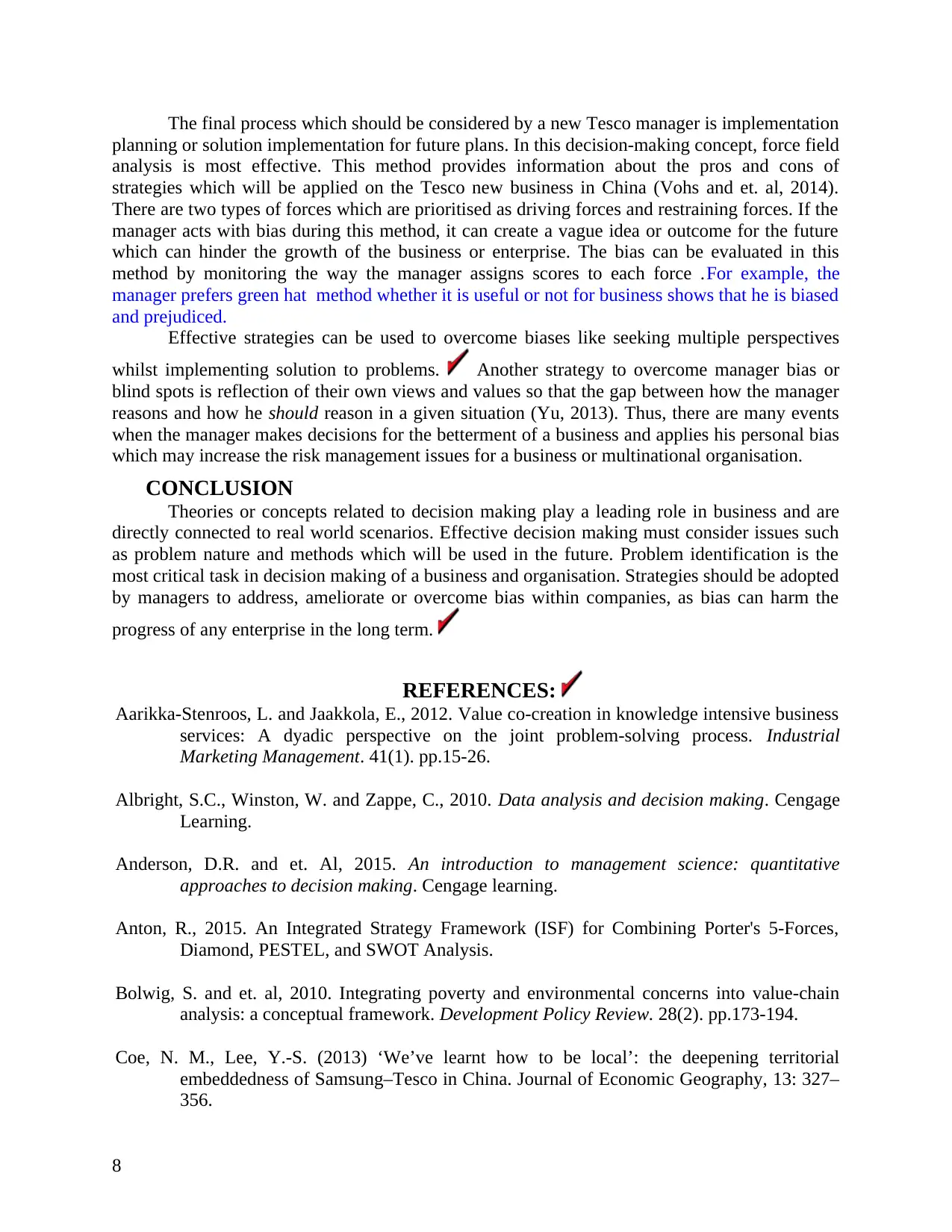
The final process which should be considered by a new Tesco manager is implementation
planning or solution implementation for future plans. In this decision-making concept, force field
analysis is most effective. This method provides information about the pros and cons of
strategies which will be applied on the Tesco new business in China (Vohs and et. al, 2014).
There are two types of forces which are prioritised as driving forces and restraining forces. If the
manager acts with bias during this method, it can create a vague idea or outcome for the future
which can hinder the growth of the business or enterprise. The bias can be evaluated in this
method by monitoring the way the manager assigns scores to each force .For example, the
manager prefers green hat method whether it is useful or not for business shows that he is biased
and prejudiced.
Effective strategies can be used to overcome biases like seeking multiple perspectives
whilst implementing solution to problems. Another strategy to overcome manager bias or
blind spots is reflection of their own views and values so that the gap between how the manager
reasons and how he should reason in a given situation (Yu, 2013). Thus, there are many events
when the manager makes decisions for the betterment of a business and applies his personal bias
which may increase the risk management issues for a business or multinational organisation.
CONCLUSION
Theories or concepts related to decision making play a leading role in business and are
directly connected to real world scenarios. Effective decision making must consider issues such
as problem nature and methods which will be used in the future. Problem identification is the
most critical task in decision making of a business and organisation. Strategies should be adopted
by managers to address, ameliorate or overcome bias within companies, as bias can harm the
progress of any enterprise in the long term.
REFERENCES:
Aarikka-Stenroos, L. and Jaakkola, E., 2012. Value co-creation in knowledge intensive business
services: A dyadic perspective on the joint problem-solving process. Industrial
Marketing Management. 41(1). pp.15-26.
Albright, S.C., Winston, W. and Zappe, C., 2010. Data analysis and decision making. Cengage
Learning.
Anderson, D.R. and et. Al, 2015. An introduction to management science: quantitative
approaches to decision making. Cengage learning.
Anton, R., 2015. An Integrated Strategy Framework (ISF) for Combining Porter's 5-Forces,
Diamond, PESTEL, and SWOT Analysis.
Bolwig, S. and et. al, 2010. Integrating poverty and environmental concerns into value‐chain
analysis: a conceptual framework. Development Policy Review. 28(2). pp.173-194.
Coe, N. M., Lee, Y.-S. (2013) ‘We’ve learnt how to be local’: the deepening territorial
embeddedness of Samsung–Tesco in China. Journal of Economic Geography, 13: 327–
356.
8
planning or solution implementation for future plans. In this decision-making concept, force field
analysis is most effective. This method provides information about the pros and cons of
strategies which will be applied on the Tesco new business in China (Vohs and et. al, 2014).
There are two types of forces which are prioritised as driving forces and restraining forces. If the
manager acts with bias during this method, it can create a vague idea or outcome for the future
which can hinder the growth of the business or enterprise. The bias can be evaluated in this
method by monitoring the way the manager assigns scores to each force .For example, the
manager prefers green hat method whether it is useful or not for business shows that he is biased
and prejudiced.
Effective strategies can be used to overcome biases like seeking multiple perspectives
whilst implementing solution to problems. Another strategy to overcome manager bias or
blind spots is reflection of their own views and values so that the gap between how the manager
reasons and how he should reason in a given situation (Yu, 2013). Thus, there are many events
when the manager makes decisions for the betterment of a business and applies his personal bias
which may increase the risk management issues for a business or multinational organisation.
CONCLUSION
Theories or concepts related to decision making play a leading role in business and are
directly connected to real world scenarios. Effective decision making must consider issues such
as problem nature and methods which will be used in the future. Problem identification is the
most critical task in decision making of a business and organisation. Strategies should be adopted
by managers to address, ameliorate or overcome bias within companies, as bias can harm the
progress of any enterprise in the long term.
REFERENCES:
Aarikka-Stenroos, L. and Jaakkola, E., 2012. Value co-creation in knowledge intensive business
services: A dyadic perspective on the joint problem-solving process. Industrial
Marketing Management. 41(1). pp.15-26.
Albright, S.C., Winston, W. and Zappe, C., 2010. Data analysis and decision making. Cengage
Learning.
Anderson, D.R. and et. Al, 2015. An introduction to management science: quantitative
approaches to decision making. Cengage learning.
Anton, R., 2015. An Integrated Strategy Framework (ISF) for Combining Porter's 5-Forces,
Diamond, PESTEL, and SWOT Analysis.
Bolwig, S. and et. al, 2010. Integrating poverty and environmental concerns into value‐chain
analysis: a conceptual framework. Development Policy Review. 28(2). pp.173-194.
Coe, N. M., Lee, Y.-S. (2013) ‘We’ve learnt how to be local’: the deepening territorial
embeddedness of Samsung–Tesco in China. Journal of Economic Geography, 13: 327–
356.
8
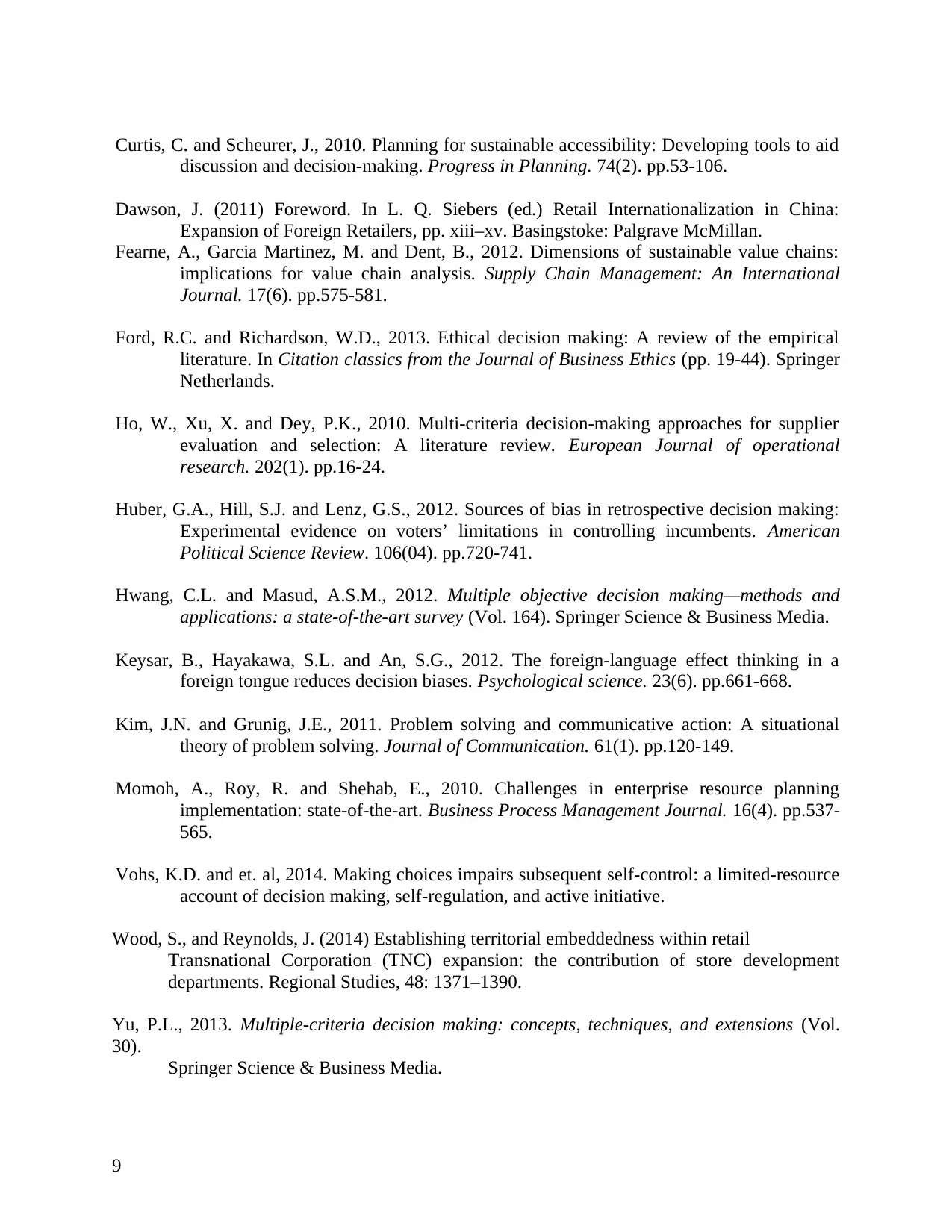
Curtis, C. and Scheurer, J., 2010. Planning for sustainable accessibility: Developing tools to aid
discussion and decision-making. Progress in Planning. 74(2). pp.53-106.
Dawson, J. (2011) Foreword. In L. Q. Siebers (ed.) Retail Internationalization in China:
Expansion of Foreign Retailers, pp. xiii–xv. Basingstoke: Palgrave McMillan.
Fearne, A., Garcia Martinez, M. and Dent, B., 2012. Dimensions of sustainable value chains:
implications for value chain analysis. Supply Chain Management: An International
Journal. 17(6). pp.575-581.
Ford, R.C. and Richardson, W.D., 2013. Ethical decision making: A review of the empirical
literature. In Citation classics from the Journal of Business Ethics (pp. 19-44). Springer
Netherlands.
Ho, W., Xu, X. and Dey, P.K., 2010. Multi-criteria decision-making approaches for supplier
evaluation and selection: A literature review. European Journal of operational
research. 202(1). pp.16-24.
Huber, G.A., Hill, S.J. and Lenz, G.S., 2012. Sources of bias in retrospective decision making:
Experimental evidence on voters’ limitations in controlling incumbents. American
Political Science Review. 106(04). pp.720-741.
Hwang, C.L. and Masud, A.S.M., 2012. Multiple objective decision making—methods and
applications: a state-of-the-art survey (Vol. 164). Springer Science & Business Media.
Keysar, B., Hayakawa, S.L. and An, S.G., 2012. The foreign-language effect thinking in a
foreign tongue reduces decision biases. Psychological science. 23(6). pp.661-668.
Kim, J.N. and Grunig, J.E., 2011. Problem solving and communicative action: A situational
theory of problem solving. Journal of Communication. 61(1). pp.120-149.
Momoh, A., Roy, R. and Shehab, E., 2010. Challenges in enterprise resource planning
implementation: state-of-the-art. Business Process Management Journal. 16(4). pp.537-
565.
Vohs, K.D. and et. al, 2014. Making choices impairs subsequent self-control: a limited-resource
account of decision making, self-regulation, and active initiative.
Wood, S., and Reynolds, J. (2014) Establishing territorial embeddedness within retail
Transnational Corporation (TNC) expansion: the contribution of store development
departments. Regional Studies, 48: 1371–1390.
Yu, P.L., 2013. Multiple-criteria decision making: concepts, techniques, and extensions (Vol.
30).
Springer Science & Business Media.
9
discussion and decision-making. Progress in Planning. 74(2). pp.53-106.
Dawson, J. (2011) Foreword. In L. Q. Siebers (ed.) Retail Internationalization in China:
Expansion of Foreign Retailers, pp. xiii–xv. Basingstoke: Palgrave McMillan.
Fearne, A., Garcia Martinez, M. and Dent, B., 2012. Dimensions of sustainable value chains:
implications for value chain analysis. Supply Chain Management: An International
Journal. 17(6). pp.575-581.
Ford, R.C. and Richardson, W.D., 2013. Ethical decision making: A review of the empirical
literature. In Citation classics from the Journal of Business Ethics (pp. 19-44). Springer
Netherlands.
Ho, W., Xu, X. and Dey, P.K., 2010. Multi-criteria decision-making approaches for supplier
evaluation and selection: A literature review. European Journal of operational
research. 202(1). pp.16-24.
Huber, G.A., Hill, S.J. and Lenz, G.S., 2012. Sources of bias in retrospective decision making:
Experimental evidence on voters’ limitations in controlling incumbents. American
Political Science Review. 106(04). pp.720-741.
Hwang, C.L. and Masud, A.S.M., 2012. Multiple objective decision making—methods and
applications: a state-of-the-art survey (Vol. 164). Springer Science & Business Media.
Keysar, B., Hayakawa, S.L. and An, S.G., 2012. The foreign-language effect thinking in a
foreign tongue reduces decision biases. Psychological science. 23(6). pp.661-668.
Kim, J.N. and Grunig, J.E., 2011. Problem solving and communicative action: A situational
theory of problem solving. Journal of Communication. 61(1). pp.120-149.
Momoh, A., Roy, R. and Shehab, E., 2010. Challenges in enterprise resource planning
implementation: state-of-the-art. Business Process Management Journal. 16(4). pp.537-
565.
Vohs, K.D. and et. al, 2014. Making choices impairs subsequent self-control: a limited-resource
account of decision making, self-regulation, and active initiative.
Wood, S., and Reynolds, J. (2014) Establishing territorial embeddedness within retail
Transnational Corporation (TNC) expansion: the contribution of store development
departments. Regional Studies, 48: 1371–1390.
Yu, P.L., 2013. Multiple-criteria decision making: concepts, techniques, and extensions (Vol.
30).
Springer Science & Business Media.
9
⊘ This is a preview!⊘
Do you want full access?
Subscribe today to unlock all pages.

Trusted by 1+ million students worldwide
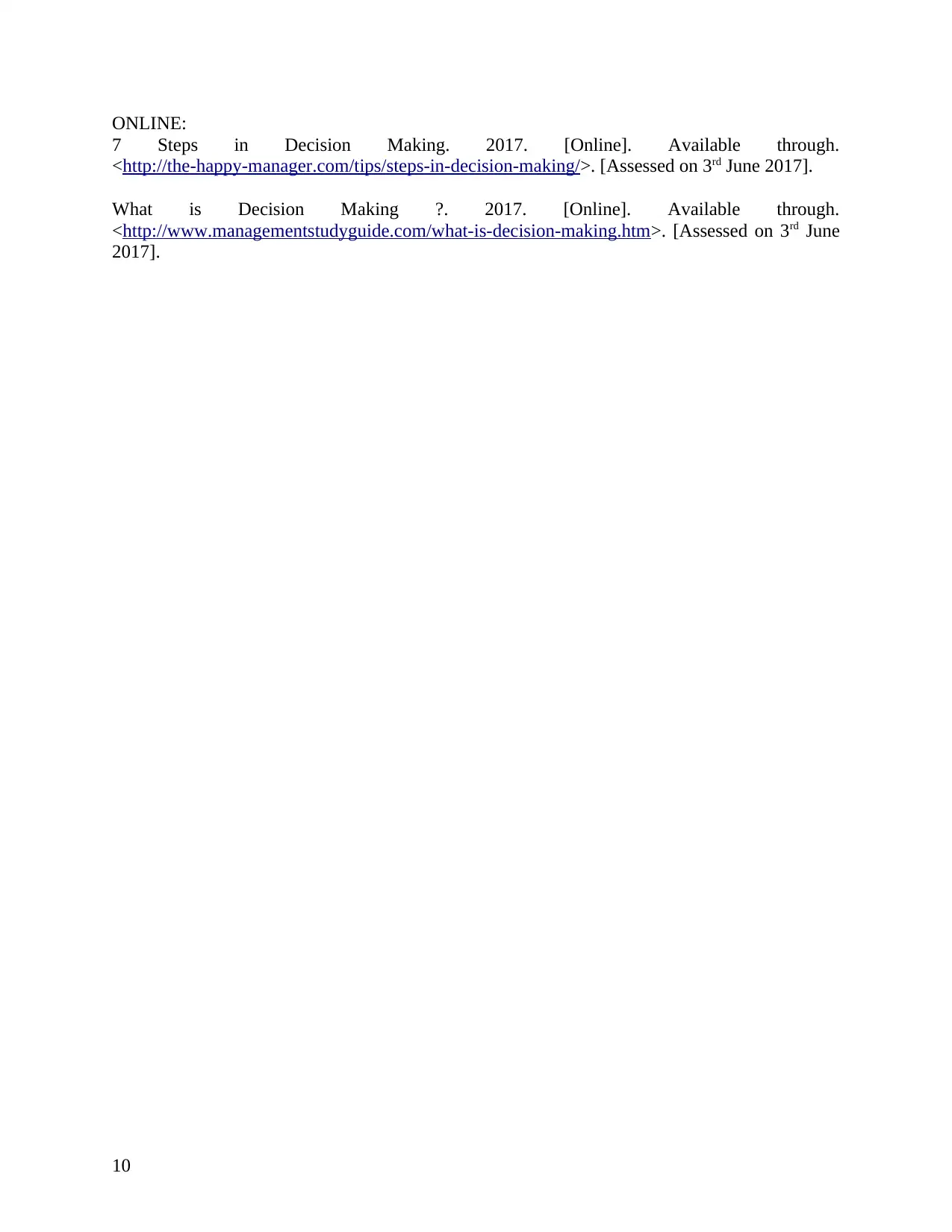
ONLINE:
7 Steps in Decision Making. 2017. [Online]. Available through.
<http://the-happy-manager.com/tips/steps-in-decision-making/>. [Assessed on 3rd June 2017].
What is Decision Making ?. 2017. [Online]. Available through.
<http://www.managementstudyguide.com/what-is-decision-making.htm>. [Assessed on 3rd June
2017].
10
7 Steps in Decision Making. 2017. [Online]. Available through.
<http://the-happy-manager.com/tips/steps-in-decision-making/>. [Assessed on 3rd June 2017].
What is Decision Making ?. 2017. [Online]. Available through.
<http://www.managementstudyguide.com/what-is-decision-making.htm>. [Assessed on 3rd June
2017].
10
Paraphrase This Document
Need a fresh take? Get an instant paraphrase of this document with our AI Paraphraser
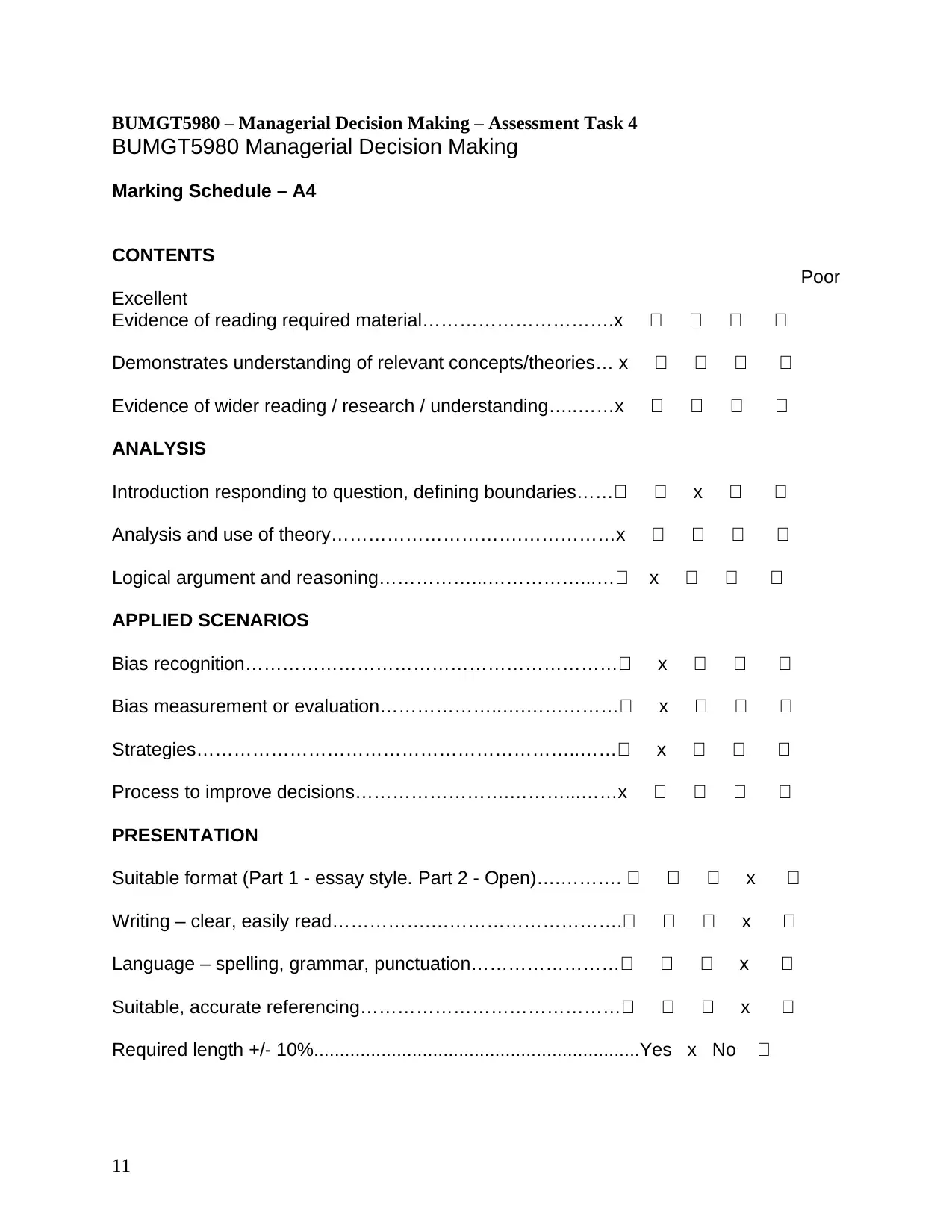
BUMGT5980 – Managerial Decision Making – Assessment Task 4
BUMGT5980 Managerial Decision Making
Marking Schedule – A4
CONTENTS
Poor
Excellent
Evidence of reading required material………………………….x
Demonstrates understanding of relevant concepts/theories… x
Evidence of wider reading / research / understanding…..……x
ANALYSIS
Introduction responding to question, defining boundaries…… x
Analysis and use of theory………………………….……………x
Logical argument and reasoning……………...……………...… x
APPLIED SCENARIOS
Bias recognition…………………………………………………… x
Bias measurement or evaluation………………..….…………… x
Strategies……………………………………………………..…… x
Process to improve decisions…………………….………...……x
PRESENTATION
Suitable format (Part 1 - essay style. Part 2 - Open)….………. x
Writing – clear, easily read…………….…………………………. x
Language – spelling, grammar, punctuation…………………… x
Suitable, accurate referencing…………………………………… x
Required length +/- 10%...............................................................Yes x No
11
BUMGT5980 Managerial Decision Making
Marking Schedule – A4
CONTENTS
Poor
Excellent
Evidence of reading required material………………………….x
Demonstrates understanding of relevant concepts/theories… x
Evidence of wider reading / research / understanding…..……x
ANALYSIS
Introduction responding to question, defining boundaries…… x
Analysis and use of theory………………………….……………x
Logical argument and reasoning……………...……………...… x
APPLIED SCENARIOS
Bias recognition…………………………………………………… x
Bias measurement or evaluation………………..….…………… x
Strategies……………………………………………………..…… x
Process to improve decisions…………………….………...……x
PRESENTATION
Suitable format (Part 1 - essay style. Part 2 - Open)….………. x
Writing – clear, easily read…………….…………………………. x
Language – spelling, grammar, punctuation…………………… x
Suitable, accurate referencing…………………………………… x
Required length +/- 10%...............................................................Yes x No
11
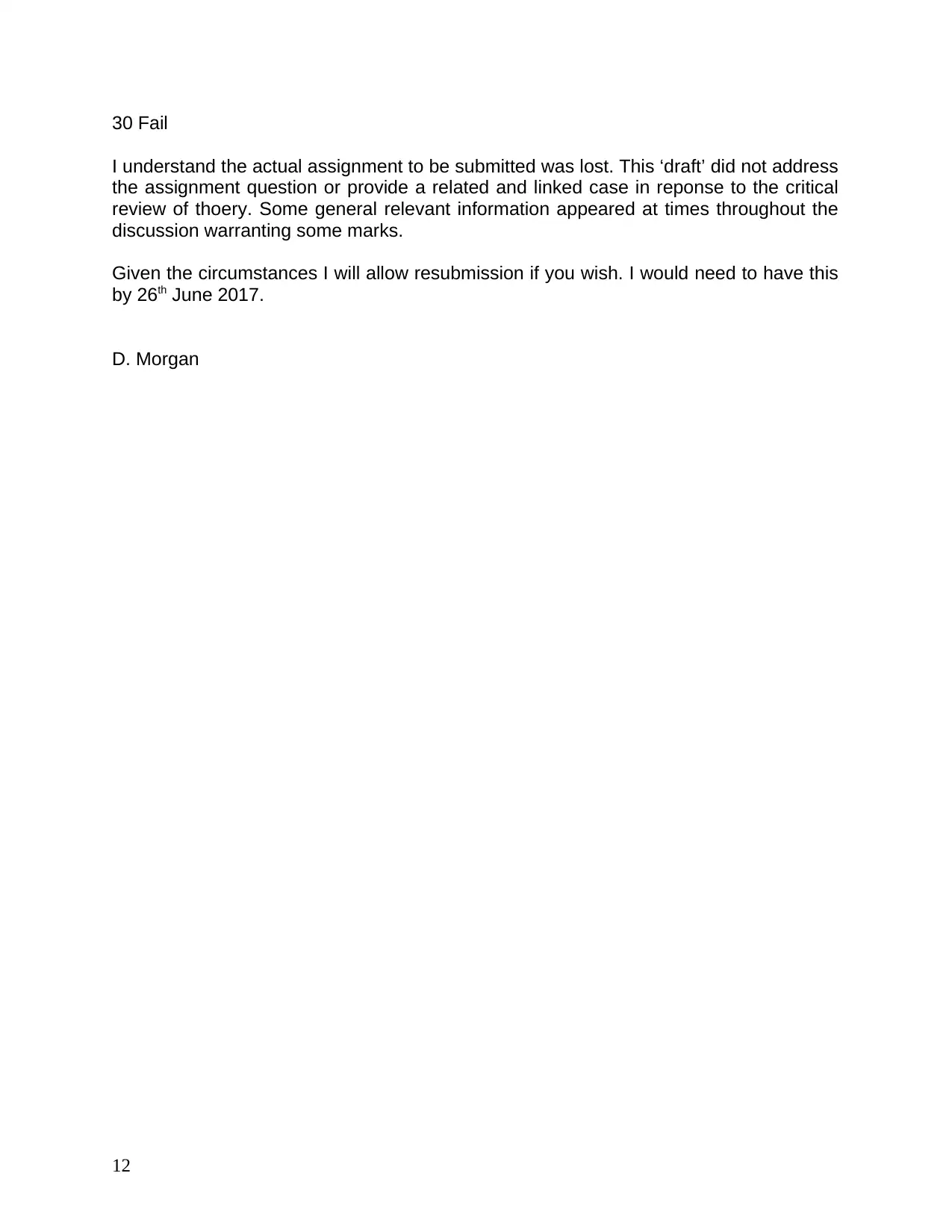
30 Fail
I understand the actual assignment to be submitted was lost. This ‘draft’ did not address
the assignment question or provide a related and linked case in reponse to the critical
review of thoery. Some general relevant information appeared at times throughout the
discussion warranting some marks.
Given the circumstances I will allow resubmission if you wish. I would need to have this
by 26th June 2017.
D. Morgan
12
I understand the actual assignment to be submitted was lost. This ‘draft’ did not address
the assignment question or provide a related and linked case in reponse to the critical
review of thoery. Some general relevant information appeared at times throughout the
discussion warranting some marks.
Given the circumstances I will allow resubmission if you wish. I would need to have this
by 26th June 2017.
D. Morgan
12
⊘ This is a preview!⊘
Do you want full access?
Subscribe today to unlock all pages.

Trusted by 1+ million students worldwide
1 out of 12
Related Documents
Your All-in-One AI-Powered Toolkit for Academic Success.
+13062052269
info@desklib.com
Available 24*7 on WhatsApp / Email
![[object Object]](/_next/static/media/star-bottom.7253800d.svg)
Unlock your academic potential
Copyright © 2020–2025 A2Z Services. All Rights Reserved. Developed and managed by ZUCOL.





